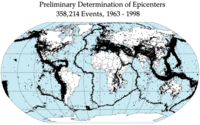
Photo from wikipedia
Abstract The different scales of the pore and fracture structure in shale have an enormous impact on the occurrence and migration of shale gas. At present, many scholars are focused… Click to show full abstract
Abstract The different scales of the pore and fracture structure in shale have an enormous impact on the occurrence and migration of shale gas. At present, many scholars are focused largely on the study of marine shale, but seldom on marine–continental transitional or continental coal shale. In this work, we used high-performance field emission scanning electron microscopy (FESEM) and a low pressure N 2 adsorption to study the pore structure characteristics of coal-bearing shale from the Yuzhou coalfield, China. The pores of coal-bearing shale are classified as intergranular, intraparticle, and organic matter (OM) pores and natural fractures based on the location of their occurrence, which is mainly of the mesopore (2–50 nm) and macropore (>50 nm) size ranges. In theory, these can provide void space for the occurrence of shale gas. The pore structure mainly consists of slit-shaped pores. Mesopores contribute the largest pore volume and specific surface area (SSA), whilst the second most significant pore size range is macropores. There are a large proportion of mesopores in the 2–10 nm pore size range. The TOC content cannot reflect the positive correlated with the BET specific surface area and the BJH total pore volume. Clay minerals are the positive factor controlling the total pore volume and specific surface area. However, more detailed characterization of coal-bearing shale is necessary. In future, the co-existence and alternation of coal, organic shale, and tight sandstone make a possibility for joint development of multiple unconventional gases.
Journal Title: Journal of Petroleum Science and Engineering
Year Published: 2017
Link to full text (if available)
Share on Social Media: Sign Up to like & get
recommendations!